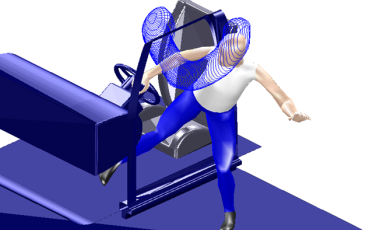Models of human beings: their impacts on tomorrow's mobility
Philippe Vezin, Scientific coordinator of the science topic, Gustave Eiffel University
Mobility is a societal issue. Travelling is a normal day-to-day activity which everybody wishes to be safer, more comfortable and accessible. Travelling is also an important factor of socialisation, allowing people to avoid isolation and exclusion.
Changing transport means and systems
Everyday life is changing with the rise of new modes of transportation, the arrival of the automatic or autonomous cars, the emergence of soft transport modes and the increase of the public transports’ use. Going with these changes is a major concern of the sector actors whether political, industrial or academic. The complexity of the system to be studied, which has absolutely to take into account the individual and theirs particularities, can only be tackled with a massive use of the numerical simulation and virtualization allowed by the increased power of informatics.
Models that take account of the complexity of being human
Modelling the human being, who is at the centre of the system, represents a real scientific challenge for us today, even if we consider only the physical and biomechanical dimension. There is a considerable degree of morphometric variability, as well as major physical and mechanical differences from one individual to another. These characteristics are also changing over time, as a result of ageing, or simply physiology as a result of the individual’s state of health at a given time.
Moreover, the different components that make up an individual’s physical mobility, or the various events which can occur during a journey require a variety of modelling approaches. For this reason researchers at the LBMC are exploring various approaches to modelling the human being in order to provide those who require them (vehicle designers, surgeons etc.) with tools for evaluating and predicting the biomechanical behaviour of human beings. The models in question take account of both interand intra-individual variability. These tools allow us to construct specific models that provide a more faithful representation of the patient. They are also of assistance in the fields of post-traumatic and pathological surgery. Other approaches may be used in order to design protective equipment or the vehicle passenger compartments (ergonomics) in order for them suitable for the largest possible number of individuals.
New tools to anticipate the travels
Each application requires its own model. These are used throughout the travel cycle to better anticipate thereof. From simply the walk, first mode of travel, up to the post-accident repair, the biomechanical simulation tells the story of your travel. First of all, going to the chosen mode of transport, access and take place in the vehicle. This activity could be more ergonomics and comfortable thanks to a new design also taking into account the specific characteristics of reduced mobility people. The vehicle and the on-board systems, thanks to the pre-crash simulation tools, could be designed to better prevent, mitigate or avoid an eventual crash. Predictive models of injuries will allow the development of smart and efficient protective systems to reduce at the most the severity of the impact. Finally, your own model, that means a patient-specific model, will help the surgeons for a better diagnostic and evaluation pre and postoperative to optimize the surgery and the rehabilitation.
The various components of an individual’s physical mobility require multiple modeling approaches.

Credit : LBMC laboratory / Gustave Eiffel University
Summary
Introduction
Improving the confort and accessibility of transport vehicles
- By Xuguang Wang
Taking account of how individuals react to a risk
The risk of injury as the result of an accident
- By David Mitton
Optimising functional rehabilitation
Using virtual tests
- By Jean-Pierre Verriest
Identity card of the science topic
| Title: | Models of human beings: their impacts on tomorrow's mobiliy |
| Coordinator: | Philippe Vezin |
| Authors: | Philippe Vezin, Xuguang Wang, Thomas Robert, David Mitton, Raphaël Dumas, Jean-Pierre Verriest |
| Collection: | Ifsttar sciences topics |
| Version: | PDF for free download in web and print versions |
| Licence: | Creative Common CC BY-SA 4.0 |
| Publication: | February 2015, updated september 2017 |
| Languages: | French and english |
| Keywords: | Mobility, modelling, innovation, numerical simulation, Ifsttar science topics |

